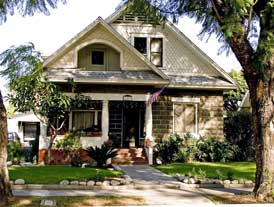
Colonial Revival is the most popular architectural style in America, and it continues to flourish today. It was inspired in part by the 1876 Centennial Celebration. The style took off in 1890 – at the time that "manifest destiny" was at its peak – when Americans began to value their own architecture and heritage. Interest in Victorian architecture was beginning to wane as Americans sought architecture that reflected American values and traditions. Colonial Revival architecture was also helped along by the reawakened interest in classicism by the dozens of American architects who had trained at the Ecole des Beaux Arts architectural school in Paris. The style was popular from 1890 to 1940, but between World War I and World War II, Colonial Revival was the most popular historic revival style in the United States.
The style derived its inspiration from American architecture around the time of the Revolutionary War, but Colonial Revival houses were considerably larger than their earlier counterparts. Characteristics of this traditional and comforting style include:
After World War II, more simplified versions of the Colonial Revival-styled house were built. California was an unusual place for the Colonial Revival style, because its colonial period was Spanish, not Anglo, as was the eastern prototype. Nevertheless, by the turn of the 20th century, the dominant culture was Anglo, and many Colonial Revival houses were built here. Many Fullerton settlers were from the Northeast and felt comfortable with this architectural style. The oldest existing building in Fullerton is a Colonial Revival dwelling – the Kerr House (1882) at 771 W. Orangethorpe Avenue. Other significant Colonial Revival buildings within the city include the Noutary House (1901) at 213 Claire Avenue; the Russell House (1903), at 516 W. Amerige Avenue (but originally at 136 W. Commonwealth Avenue); the Conway House (1903), now at 150 Marion Boulevard (moved from 145 E. Commonwealth Avenue); the former Methodist Parsonage (1905), now a commercial establishment, at 142 E. Amerige Avenue; the Fallert House (1908) at 123 E. Valencia Drive; the Robertson House (ca. 1911) at 434 W. Amerige Avenue; the Cooper House (1923) at 2208 E. Chapman Avenue; the Royer House (1925) at 1230 West Orangethorpe Avenue; and the Nenno House (1928), now a commercial establishment, at 321 N. Pomona Avenue. Colonial Revival residences in Fullerton range from modest single-story dwellings to more stately and distinguished houses.
The Colonial Revival style remained popular in Fullerton, but it was gradually displaced by the Mission Revival and Spanish Colonial Revival styles as residents sought an architecture that better reflected the Hispanic heritage of the area. In Southern California, the Mission Revival style was considered the counterpart to the Colonial Revival style popular in northeastern United States.
Read More about the Colonial Revival Style:
-213ClaireAvenue.jpg)
Noutary House (1901)
213 Claire Avenue
-516W.AmerigeAvenue.jpg)
Russell House (1903)
516 W. Amerige Avenue

Fallert House (1908)
123 E. Valencia Drive
-2208E.ChapmanAvenue.jpg)
Cooper House (1923)
2208 E. Chapman Avenue
-321N.PomonaAvenue.jpg)
Nenno House (1928)
321 N. Pomona Avenue